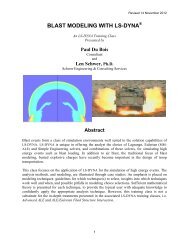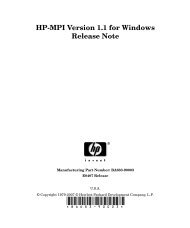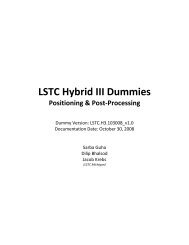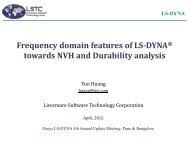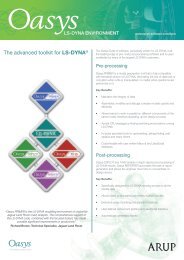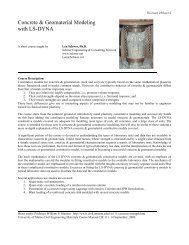Oasys LS-DYNA Environment 8.1 VOLUME 3 ... - Oasys Software
Oasys LS-DYNA Environment 8.1 VOLUME 3 ... - Oasys Software
Oasys LS-DYNA Environment 8.1 VOLUME 3 ... - Oasys Software
Create successful ePaper yourself
Turn your PDF publications into a flip-book with our unique Google optimized e-Paper software.
<strong>Oasys</strong> <strong>LS</strong>-<strong>DYNA</strong> <strong>Environment</strong>: User Guide (Version <strong>8.1</strong>)<br />
11.0 ENERGY DATA<br />
The energy data which is printed in the .LOG and .OTF files forms a useful check on an analysis.<br />
The following equation should hold at all times during an analysis.<br />
KE + IE = KE o + EW<br />
Where KE = current kinetic energy<br />
IE = current internal energy<br />
KE o = initial kinetic energy<br />
EW = external work<br />
Internal energy includes elastic strain energy and work done in permanent deformation. External<br />
work includes work done by applied forces and pressures but currently excludes work done by<br />
velocity, displacement or acceleration boundary conditions - so the equation above will appear<br />
not to hold if these features are used. By default energy absorbed by contact surfaces is excluded.<br />
In particular, work done against friction can be significant and energy being dissipated in this<br />
way will appear to be lost. However, this energy can be included by setting SLTEN to 2 on<br />
*CONTROL_ENERGY. Energy associated with hourglassing is also excluded by default, but<br />
can be included (HGEN on *CONTROL_ENERGY).<br />
The terms in the equation can all be plotted using OASYS T/HIS. If the equation does not hold<br />
the user should suspect an error. If the left hand side of the equation rises above the right hand<br />
side, energy is being introduced artificially - for example, by numerical instability, or the sudden<br />
detection of artificial penetration through a contact surface. The latter condition is often shown<br />
by sudden jumps in the total energy. If the left hand side falls below the right hand side, energy<br />
is being absorbed artificially, perhaps by excessive hourglassing or by stonewalls or overcompliant<br />
contact surfaces. Sometimes this can be due to a genuine physical effect whose energy<br />
is not countedin the balance. A typical example is friction on contact surfaces. This can be<br />
remedied using *CONTROL_ENERGY as described above.<br />
The energy in each material can also be plotted using OASYS T/HIS. If the total energy<br />
indicates an error, plotting by material can sometimes indicate where the problem is occurring.<br />
Page 11.1






